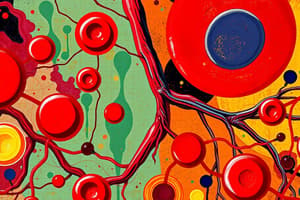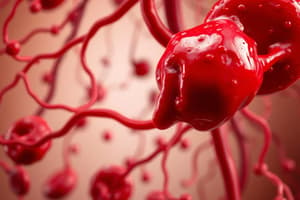Podcast
Questions and Answers
Which component of blood is responsible for transporting oxygen throughout the body?
Which component of blood is responsible for transporting oxygen throughout the body?
- Platelets
- White Blood Cells
- Plasma
- Red Blood Cells (correct)
What type of tissue is responsible for the contractions of the heart?
What type of tissue is responsible for the contractions of the heart?
- Nerve tissue
- Epithelial tissue
- Connective tissue
- Cardiac muscle tissue (correct)
Which side of the heart is responsible for pumping oxygen-rich blood to all parts of the body?
Which side of the heart is responsible for pumping oxygen-rich blood to all parts of the body?
- Both sides pump high-oxygen blood
- Left side (correct)
- Right side
- Neither, both sides pump low-oxygen blood
What is the function of capillaries in the circulatory system?
What is the function of capillaries in the circulatory system?
Which type of blood vessel has thicker walls to support blood moving with higher pressure?
Which type of blood vessel has thicker walls to support blood moving with higher pressure?
What is the function of platelets in the circulatory system?
What is the function of platelets in the circulatory system?
What is the primary function of the bronchi?
What is the primary function of the bronchi?
Which part of the respiratory system is composed of rings of cartilage to maintain its openness?
Which part of the respiratory system is composed of rings of cartilage to maintain its openness?
What is the main function of alveoli in the respiratory system?
What is the main function of alveoli in the respiratory system?
Which component of the respiratory system branches off like tree limbs from the bronchi?
Which component of the respiratory system branches off like tree limbs from the bronchi?
What is the function of mucus membranes in the nasal cavity?
What is the function of mucus membranes in the nasal cavity?
Which part of the respiratory system contains tiny cilia (hair) to trap foreign particles?
Which part of the respiratory system contains tiny cilia (hair) to trap foreign particles?
What is the primary function of the left lung?
What is the primary function of the left lung?
What is the primary purpose of bronchioles?
What is the primary purpose of bronchioles?
In which organ are alveoli located?
In which organ are alveoli located?
Flashcards are hidden until you start studying
Study Notes
Blood Components and Circulation
- Hemoglobin in red blood cells transports oxygen throughout the body.
- Cardiac muscle tissue is responsible for the contractions of the heart.
- The left side of the heart pumps oxygen-rich blood to all parts of the body.
- Capillaries facilitate the exchange of oxygen, carbon dioxide, nutrients, and waste between blood and tissues.
- Arteries have thicker walls to support blood moving under high pressure.
Functions of Blood Components
- Platelets play a crucial role in clotting to prevent bleeding and facilitate wound healing.
Respiratory System Structure and Function
- The primary function of the bronchi is to conduct air to the lungs.
- The trachea, supported by rings of cartilage, maintains open airways for unobstructed airflow.
- Alveoli are responsible for gas exchange, allowing oxygen to enter the blood and carbon dioxide to be expelled.
- The bronchi branch into smaller airways like tree limbs leading to the alveoli.
Nasal Cavity and Airway Protection
- Mucus membranes in the nasal cavity produce mucus to trap foreign particles and humidify incoming air.
- The respiratory epithelium contains tiny cilia that help trap and move foreign particles and pathogens out of the airways.
Lung Function and Airway Details
- The primary function of the left lung is to facilitate oxygen exchange and gas exchange during breathing.
- Bronchioles, the smallest airways, regulate air flow to the alveoli and play a role in airflow resistance.
- Alveoli are located within the lungs, specifically at the ends of the bronchioles where gas exchange occurs.
Studying That Suits You
Use AI to generate personalized quizzes and flashcards to suit your learning preferences.




